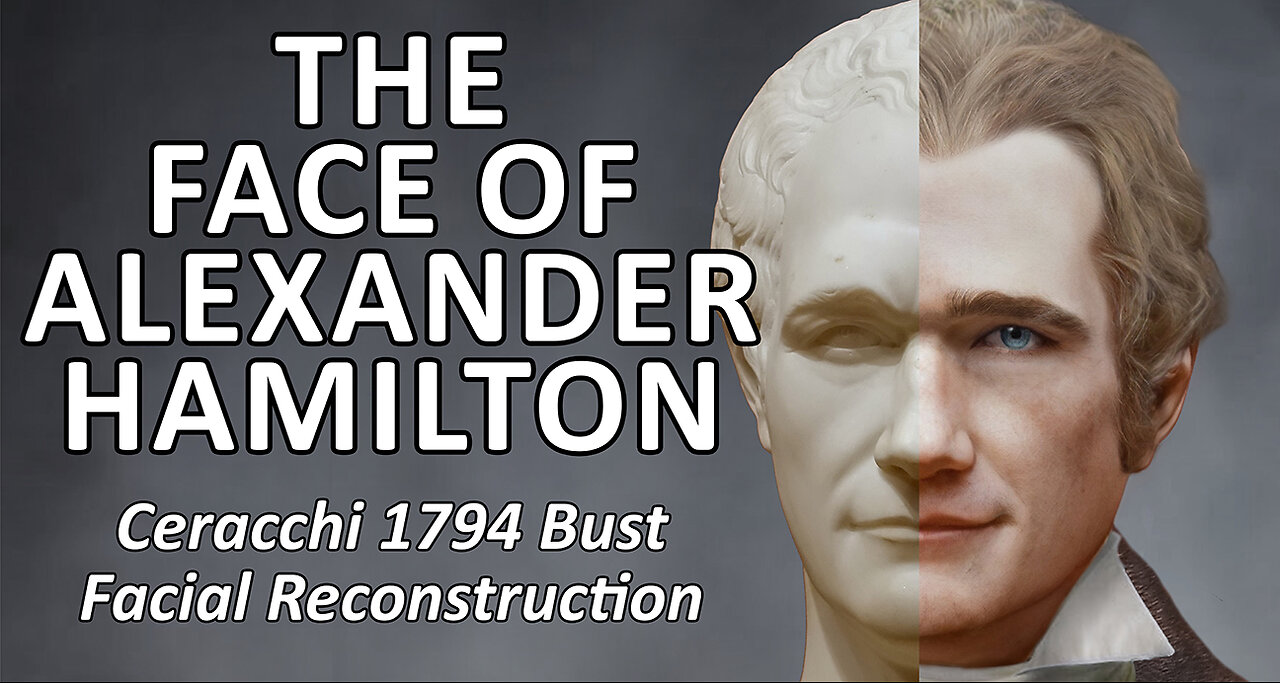Premium Only Content

The Face of Alexander Hamilton - A Facial Reconstruction of the 1794 Ceracchi bust
A Photoshop facial reconstruction of the Giuseppe Ceracchi 1794 bust of Alexander Hamilton.
0:00 - Biography
1:26 - Ceracchi 1794 bust of Hamilton
2:20 - Bust Facial Reconstruction
3:08 - End
Alexander Hamilton was a Founding Father, military officer, and statesman who served as the first Secretary of Treasury from 1789 to 1795 during George Washington's presidency. He was born on January 11, 1755, in Nevis, a British colonial island in the Caribbean, as an illegitimate child to Scotsman James Hamilton and Rachel Fawcett Levine.
In the wake of the Boston Tea Party, Hamilton dropped out of college to join the Sons of Liberty and pursue the American cause. Hamilton became one of Washington's closest military confidants and was promoted to lieutenant colonel.
After the war, Hamilton returned to New York City where he practiced law and became one of the New York delegates to the Constitutional Convention in 1787. Hamilton debated for his vision of American government and, along with James Madison and John Jay, penned The Federalist Papers, arguing for ratification of the Constitution.
In 1789, President Washington appointed Hamilton as the first Secretary of the Treasury. Hamilton also became the de facto head of the Federalist Party. However, his life was tragically cut short on July 12, 1804, when he was mortally wounded in a duel with Vice President Aaron Burr, his political rival.
Hamilton's legacy has endured throughout history, with his face appearing on the ten dollar bill and his story being told in a critically acclaimed musical bearing his name.
So, what did Hamilton really look like?
Despite the absence of life masks or photographs of Hamilton, there is an accurate depiction of him. Giuseppe Ceracchi, an Italian sculptor, created a marble bust of Hamilton in 1794. This bust served as a template for various sculptures and paintings, and is considered the most accurate representation of Hamilton. Ceracchi also crafted several replicas of the bust using both plaster and marble.
In 1896, The Atlantic Monthly published an article titled “Reminiscences of Mrs Alexander Hamilton.” The author recalled spending time with Hamilton’s widow, Eliza Schuyler Hamilton, in 1852 and being struck by the marble bust of Hamilton that she gazed at longingly. This same bust can now be viewed at the Crystal Bridges Museum of American Art in Arkansas, serving as a timeless memorial to Hamilton.
Now, let us imagine Ceracchi's bust of Hamilton being transformed into a realistic image that appears like a photograph. In this image, we can envision Hamilton as he would have looked at the age of 37, with striking piercing blue eyes and reddish-brown hair, without any powdering.
Hamilton's manners and appearance were highly esteemed by those who lived during his time. Fisher Ames, a close friend and fellow Federalist, was particularly enchanted by his deep azure eyes, which he described as "eminently beautiful," as well as his physical deportment, which he deemed as "one of the most elegant of mortals" with "easy, graceful, and polished movements." Another male contemporary also noted Hamilton's exceptional good looks, commenting on his fair complexion and almost feminine rosiness of his cheeks, making his figure and color an uncommonly handsome face."
▬About Digital Yarbs ▬▬▬▬▬▬▬▬▬▬▬▬
I'm a Photoshop composition artist who enjoys history. I reconstruct life masks, statues and busts of famous early Americans and historic figures.
Using life masks, I completed a forensic/academic study of how the subjects most likely appeared using Adobe Photoshop to add flesh, hair, and other details. My website, Digital Yarbs features reconstructions and animations of these life masks along with a little history and how the subjects might have looked in daguerreotypes and photographs.
To understand what these historic figures really looked like we cannot rely on paintings as they suffer from “artistic license” and “sympathetic treatment” commonly employed by many contemporary portrait artists. Before photography, the art form of the life mask was the best way to create an exact likeness of an individual. Basically, plaster would be applied to the head and sometimes upper torso to create a mold from which a life mask or bust of the person could be cast. This would result in a three-dimensional, faithful transfer capturing in minute detail the true likeness of the subject.
Website: https://yarbs.net/
▬ Social Media ▬▬▬▬▬▬▬▬▬▬▬▬▬▬▬
► Web: https://yarbs.net/
► Facebook: https://www.facebook.com/DigitalYarbs
► Twitter: https://twitter.com/DigitalYarbs
► Instagram: https://www.instagram.com/digitalyarbs/
► Prints Shop: https://www.etsy.com/shop/DigitalYarbs
#alexanderhamilton #hamilton #digitalyarbs #foundingfathers #lifemask #deathmask #historicalfigures
-
 2:26:11
2:26:11
Jewels Jones Live ®
1 day agoWINNING BIGLY | A Political Rendezvous - Ep. 108
87.9K33 -
 2:04:49
2:04:49
Bare Knuckle Fighting Championship
4 days agoBKFC FIGHT NIGHT MOHEGAN SUN FREE FIGHTS
33.4K1 -
 25:09
25:09
BlackDiamondGunsandGear
6 hours agoYou NEED to be Training For Whats to Come
23.5K7 -
 20:03
20:03
Sideserf Cake Studio
11 hours ago $1.26 earnedA HUNGRY HUNGRY HIPPOS CAKE THAT ACTUALLY WORKS?
26.3K9 -
 23:51
23:51
marcushouse
12 hours ago $0.89 earnedStarship’s Next Move Is Coming Sooner Than You Think!
17.5K2 -
 22:24
22:24
The Finance Hub
18 hours ago $5.87 earnedBREAKING: JOE ROGAN JUST DROPPED A MASSIVE BOMBSHELL!!!
20.7K17 -
 55:02
55:02
PMG
8 hours ago $0.54 earnedHannah Faulkner and Miriam Shaw | Moms on A Mission
13.6K -
 1:21:05
1:21:05
I_Came_With_Fire_Podcast
19 hours ago"Veteran Health, Military Culture, and American Exceptionalism" with Matt Kenney
86.1K18 -
 23:21
23:21
Simply Bitcoin
1 day ago $36.62 earned$1M Bitcoin in 2025? | Trump's Plan to End the Fed Revealed!
177K68 -
 17:19
17:19
SLS - Street League Skateboarding
17 days agoTop Moments from the Men’s Super Crown Final! Nyjah Huston, Giovanni Vianna and Gustavo Ribeiro 👑
98.6K